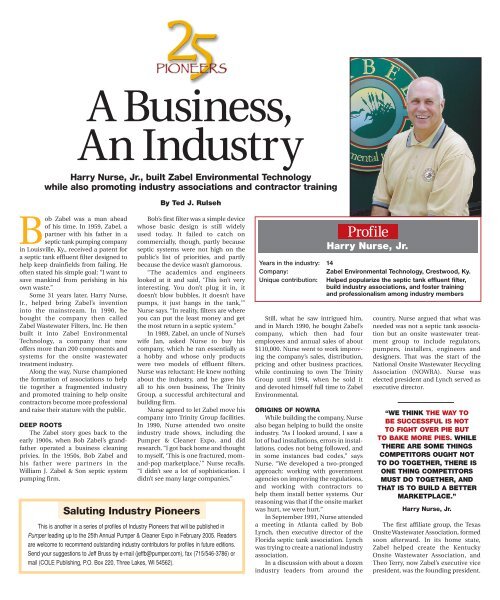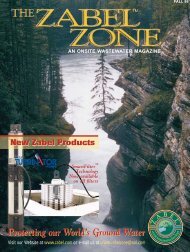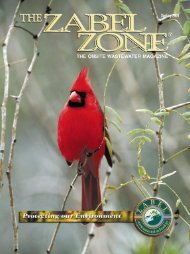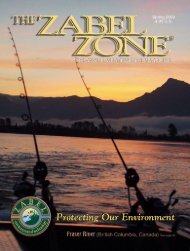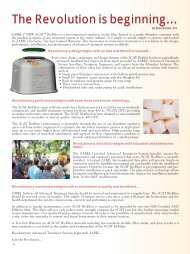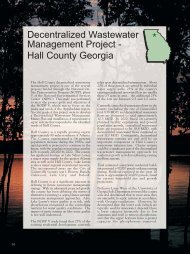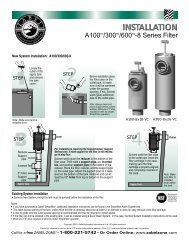A Business, An Industry - Zabel
A Business, An Industry - Zabel
A Business, An Industry - Zabel
You also want an ePaper? Increase the reach of your titles
YUMPU automatically turns print PDFs into web optimized ePapers that Google loves.
A <strong>Business</strong>,<br />
<strong>An</strong> <strong>Industry</strong><br />
Harry Nurse, Jr., built <strong>Zabel</strong> Environmental Technology<br />
while also promoting industry associations and contractor training<br />
By Ted J. Rulseh<br />
Bob <strong>Zabel</strong> was a man ahead<br />
of his time. In 1959, <strong>Zabel</strong>, a<br />
partner with his father in a<br />
septic tank pumping company<br />
in Louisville, Ky., received a patent for<br />
a septic tank effluent filter designed to<br />
help keep drainfields from failing. He<br />
often stated his simple goal: “I want to<br />
save mankind from perishing in his<br />
own waste.”<br />
Some 31 years later, Harry Nurse,<br />
Jr., helped bring <strong>Zabel</strong>’s invention<br />
into the mainstream. In 1990, he<br />
bought the company then called<br />
<strong>Zabel</strong> Wastewater Filters, Inc. He then<br />
built it into <strong>Zabel</strong> Environmental<br />
Technology, a company that now<br />
offers more than 200 components and<br />
systems for the onsite wastewater<br />
treatment industry.<br />
Along the way, Nurse championed<br />
the formation of associations to help<br />
tie together a fragmented industry<br />
and promoted training to help onsite<br />
contractors become more professional<br />
and raise their stature with the public.<br />
DEEP ROOTS<br />
The <strong>Zabel</strong> story goes back to the<br />
early 1900s, when Bob <strong>Zabel</strong>’s grandfather<br />
operated a business cleaning<br />
privies. In the 1950s, Bob <strong>Zabel</strong> and<br />
his father were partners in the<br />
William J. <strong>Zabel</strong> & Son septic system<br />
pumping firm.<br />
Bob’s first filter was a simple device<br />
whose basic design is still widely<br />
used today. It failed to catch on<br />
commercially, though, partly because<br />
septic systems were not high on the<br />
public’s list of priorities, and partly<br />
because the device wasn’t glamorous.<br />
“The academics and engineers<br />
looked at it and said, ‘This isn’t very<br />
interesting. You don’t plug it in, it<br />
doesn’t blow bubbles, it doesn’t have<br />
pumps, it just hangs in the tank,’”<br />
Nurse says. “In reality, filters are where<br />
you can put the least money and get<br />
the most return in a septic system.”<br />
In 1989, <strong>Zabel</strong>, an uncle of Nurse’s<br />
wife Jan, asked Nurse to buy his<br />
company, which he ran essentially as<br />
a hobby and whose only products<br />
were two models of effluent filters.<br />
Nurse was reluctant: He knew nothing<br />
about the industry, and he gave his<br />
all to his own business, The Trinity<br />
Group, a successful architectural and<br />
building firm.<br />
Nurse agreed to let <strong>Zabel</strong> move his<br />
company into Trinity Group facilities.<br />
In 1990, Nurse attended two onsite<br />
industry trade shows, including the<br />
Pumper & Cleaner Expo, and did<br />
research. “I got back home and thought<br />
to myself, ‘This is one fractured, momand-pop<br />
marketplace,’” Nurse recalls.<br />
“I didn’t see a lot of sophistication. I<br />
didn’t see many large companies.”<br />
Saluting <strong>Industry</strong> Pioneers<br />
This is another in a series of profiles of <strong>Industry</strong> Pioneers that will be published in<br />
Pumper leading up to the 25th <strong>An</strong>nual Pumper & Cleaner Expo in February 2005. Readers<br />
are welcome to recommend outstanding industry contributors for profiles in future editions.<br />
Send your suggestions to Jeff Bruss by e-mail (jeffb@pumper.com), fax (715/546-3786) or<br />
mail (COLE Publishing, P.O. Box 220, Three Lakes, WI 54562).<br />
Still, what he saw intrigued him,<br />
and in March 1990, he bought <strong>Zabel</strong>’s<br />
company, which then had four<br />
employees and annual sales of about<br />
$110,000. Nurse went to work improving<br />
the company’s sales, distribution,<br />
pricing and other business practices,<br />
while continuing to own The Trinity<br />
Group until 1994, when he sold it<br />
and devoted himself full time to <strong>Zabel</strong><br />
Environmental.<br />
ORIGINS OF NOWRA<br />
While building the company, Nurse<br />
also began helping to build the onsite<br />
industry. “As I looked around, I saw a<br />
lot of bad installations, errors in installations,<br />
codes not being followed, and<br />
in some instances bad codes,” says<br />
Nurse. “We developed a two-pronged<br />
approach: working with government<br />
agencies on improving the regulations,<br />
and working with contractors to<br />
help them install better systems. Our<br />
reasoning was that if the onsite market<br />
was hurt, we were hurt.”<br />
In September 1991, Nurse attended<br />
a meeting in Atlanta called by Bob<br />
Lynch, then executive director of the<br />
Florida septic tank association. Lynch<br />
was trying to create a national industry<br />
association.<br />
In a discussion with about a dozen<br />
industry leaders from around the<br />
Profile<br />
Harry Nurse, Jr.<br />
Years in the industry: 14<br />
Company:<br />
<strong>Zabel</strong> Environmental Technology, Crestwood, Ky.<br />
Unique contribution: Helped popularize the septic tank effluent filter,<br />
build industry associations, and foster training<br />
and professionalism among industry members<br />
country, Nurse argued that what was<br />
needed was not a septic tank association<br />
but an onsite wastewater treatment<br />
group to include regulators,<br />
pumpers, installers, engineers and<br />
designers. That was the start of the<br />
National Onsite Wastewater Recycling<br />
Association (NOWRA). Nurse was<br />
elected president and Lynch served as<br />
executive director.<br />
“WE THINK THE WAY TO<br />
BE SUCCESSFUL IS NOT<br />
TO FIGHT OVER PIE BUT<br />
TO BAKE MORE PIES. WHILE<br />
THERE ARE SOME THINGS<br />
COMPETITORS OUGHT NOT<br />
TO DO TOGETHER, THERE IS<br />
ONE THING COMPETITORS<br />
MUST DO TOGETHER, AND<br />
THAT IS TO BUILD A BETTER<br />
MARKETPLACE.”<br />
Harry Nurse, Jr.<br />
The first affiliate group, the Texas<br />
Onsite Wastewater Association, formed<br />
soon afterward. In its home state,<br />
<strong>Zabel</strong> helped create the Kentucky<br />
Onsite Wastewater Association, and<br />
Theo Terry, now <strong>Zabel</strong>’s executive vice<br />
president, was the founding president.
Harry Nurse, Jr., and<br />
<strong>Zabel</strong> Environmental<br />
Technology took installer<br />
training on the road and<br />
reached numerous<br />
contractors with stateapproved<br />
programs.<br />
“YOU CAN’T DO TRAINING IN ONE PLACE AT ONE TIME AND SAY,<br />
‘Y’ALL COME,’ AND HOPE PEOPLE SHOW UP. YOU GET ON<br />
YOUR HORSE AND YOU RIDE OUT TO THE COUNTIES AND YOU<br />
DO THE TRAINING WHERE THE CONTRACTORS ARE.”<br />
Harry Nurse, Jr.<br />
NOWRA now has 25 affiliate state<br />
onsite wastewater associations.<br />
In 1998, Nurse and colleagues<br />
drove the formation of the Association<br />
for Installers and Manufacturers<br />
(AIM), devoted to training installation<br />
contractors. “Manufacturers had the<br />
biggest stake in a well trained installer<br />
base,” Nurse says. “We needed to<br />
improve the experience of the homeowner<br />
and the general contractor who<br />
buys the installer’s services. We needed<br />
to improve the experience of regulators<br />
dealing with contractors. You<br />
can only accomplish that by training<br />
contractors.<br />
“We formed AIM, and then we<br />
contacted association groups throughout<br />
the United States and asked them<br />
if they wanted to take part in training.<br />
We got an overwhelming response.<br />
A dozen manufacturers signed up,<br />
including two of our big competitors in<br />
the filter market.<br />
“We opened our market to them<br />
by going to places where we had<br />
contacts and taking them with us. We<br />
think the way to be successful is not to<br />
fight over pie but to bake more pies.<br />
While there are some things competitors<br />
ought not to do together, there<br />
is one thing competitors must do<br />
together, and that is to build a better<br />
marketplace.” AIM reached a total of<br />
some 10,000 members and held a<br />
dozen conferences and numerous<br />
training programs before it moved<br />
under NOWRA’s umbrella in 2002.<br />
TRAINING ON THE ROAD<br />
On top of its association involvement,<br />
<strong>Zabel</strong> Environmental undertook<br />
training on its own. That effort began<br />
in Kentucky, where the state had just<br />
passed a regulation that required<br />
installers to earn continuing education<br />
units. More than 400 people attended<br />
the first two-day training session put<br />
on by representatives from <strong>Zabel</strong> and<br />
other manufacturers, and state and<br />
county health department personnel.<br />
Later, <strong>Zabel</strong> took training out to<br />
the contractors to make attendance as<br />
convenient as possible for them. “You<br />
can’t do training in one place at one<br />
time and say, ‘Y’all come,’ and hope<br />
people show up,” Nurse says. “You get<br />
on your horse and you ride out to the<br />
counties and you do the training<br />
where the contractors are.”<br />
<strong>Zabel</strong> still conducts training programs,<br />
often under the auspices of<br />
state associations or local health<br />
department, and always using course<br />
materials written and approved by<br />
state officials. “We have trained<br />
thousands of installers,” says Nurse.<br />
“Last year, we trained about 900 in<br />
Kentucky alone.”<br />
WALKING THE TALK<br />
In striving to professionalize the<br />
industry, Nurse has held <strong>Zabel</strong> to high<br />
professional standards of its own.<br />
Its product portfolio is designed to<br />
provide one-stop shopping for contractors.<br />
The company has been fully<br />
computerized since 1994 and ships<br />
same-day on orders received by noon.<br />
Marketing materials include the<br />
<strong>Zabel</strong> Zone, a magazine for contractors,<br />
regulators, engineers and academics.<br />
The entire product catalog is available<br />
on the company web site, and an<br />
online store simplifies shopping.<br />
Bob <strong>Zabel</strong>, who died at age 86 in<br />
1997, could not have envisioned what<br />
he started with his simple effluent<br />
filter back in the 1950s. But, chances<br />
are, if he could see what has become of<br />
the company that still bears his name,<br />
he would be pleased and proud. ■<br />
© 2004, COLE Publishing Inc.<br />
Reprinted with permission from<br />
August 2004<br />
COLE Publishing<br />
1720 Maple Lake Dam Rd.<br />
P.O. Box 220<br />
Three Lakes, WI 54562<br />
800-257-7222<br />
www.pumper.com


